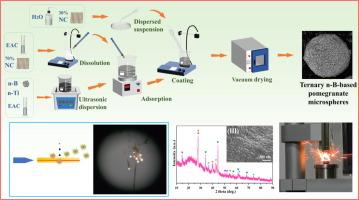基于新型溶解-分散-包衣方法的 n-B 石榴微球的精确制备和优异的燃烧性能
IF 13.3
1区 工程技术
Q1 ENGINEERING, CHEMICAL
引用次数: 0
摘要
为了提高硼粉的反应性和燃烧效果,研究人员开发了一种新的溶解-分散-涂层(DDC)方法来制造纳米硼(n-B)石榴微球。金属纳米颗粒被均匀地包裹在 n-B 微球中,微球的大小从 2 微米到 500 微米不等。研究了微球结构的球化机理。随后,分别在 0.2 和 0.5 兆帕下进行了燃烧试验,评估了制备的石榴微球的点火和燃烧性能。结果表明,F5 的 n-B 微球(75 wt% n-B@17 wt% NC@8 wt% n-Ti)性能优越,火焰面积最大,点火延迟时间和燃烧时间最短。燃烧热值和燃烧残余物分析表明,F5 微球中的可用硼含量超过 72.6%,且燃烧完全。这项研究为提高 n-B 粉末的点火和燃烧效率提供了一种新方法。本文章由计算机程序翻译,如有差异,请以英文原文为准。

Precise fabrication and superior combustion properties of n-B pomegranate microspheres based on a new dissolution-dispersion-coating method
To enhance the reactivity and combustion efficacy of boron powders, a new dissolution-dispersion-coating (DDC) method of fabricating nano-boron (n-B) pomegranate microspheres were developed. Metal nanoparticles were uniformly encapsulated within n-B microspheres, which varied in size from 2 to 500 μm. The spheroidization mechanism of microsphere structure was investigated. Subsequently, the ignition and combustion performance of the prepared pomegranate microspheres were evaluated by combustion tests at 0.2 and 0.5 MPa, respectively. The results demonstrated that the n-B microspheres of F5 (75 wt% n-B@17 wt% NC@8 wt% n-Ti) exhibited superior performances, achieving the largest flame area, minimal ignition delay time and combustion time. The combustion thermal value and combustion residue analysis indicated that the content of available boron in the F5 microspheres exceeded 72.6 % and the combustion was complete. This study provides a novel approach to enhance the ignition and combustion efficiency of n-B powders.
求助全文
通过发布文献求助,成功后即可免费获取论文全文。
去求助
来源期刊

Chemical Engineering Journal
工程技术-工程:化工
CiteScore
21.70
自引率
9.30%
发文量
6781
审稿时长
2.4 months
期刊介绍:
The Chemical Engineering Journal is an international research journal that invites contributions of original and novel fundamental research. It aims to provide an international platform for presenting original fundamental research, interpretative reviews, and discussions on new developments in chemical engineering. The journal welcomes papers that describe novel theory and its practical application, as well as those that demonstrate the transfer of techniques from other disciplines. It also welcomes reports on carefully conducted experimental work that is soundly interpreted. The main focus of the journal is on original and rigorous research results that have broad significance. The Catalysis section within the Chemical Engineering Journal focuses specifically on Experimental and Theoretical studies in the fields of heterogeneous catalysis, molecular catalysis, and biocatalysis. These studies have industrial impact on various sectors such as chemicals, energy, materials, foods, healthcare, and environmental protection.
 求助内容:
求助内容: 应助结果提醒方式:
应助结果提醒方式:


